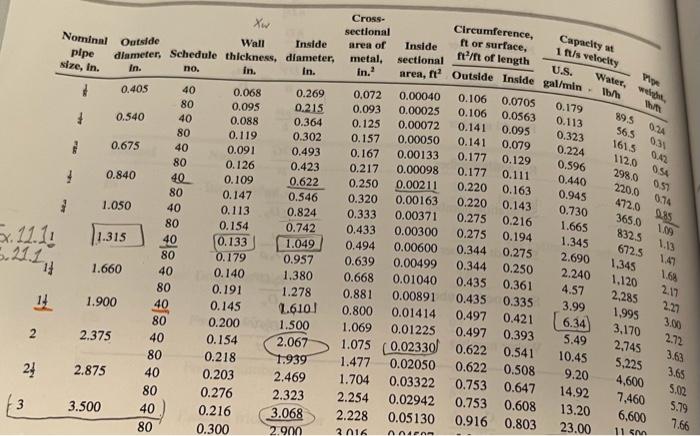Hot water is used to heat air in a double-pipe heat exchanger. The heat transfer coefficients on the water side and on the air side are 100 Btu/hr.ft2.F and 10 Btu/hr.ft2. F respectively. The heat exchanger pipe is 2-inch, schedule 40 steel (k= 54 W/m K) with water inside. a) Calculate the overall heat transfer coefficient based on the outer diameter. Express you answer in Btu/hr.ft2.F and W/m2. C. Show work. b) Assume that a fouling factor of 1,000 Btu/hr.ft2.F based on the tube outside diameter has developed over time, calculate the overall heat transfer coefficient based on the outer diameter. Express you answer in Btu/hr.ft2.F and W/m2.C. Nominal Outside pipe size, in. Xw Wall Inside diameter, Schedule thickness, diameter, In. no. in. in. Cross- sectional area of metal, Inside sectional in. U.S. We 0.125 02A 0.250 0.405 40 0.068 80 0.095 # 0.540 40 0.088 80 0.119 0.675 40 0.091 80 0.126 0.840 40 0.109 80 0.147 1.050 40 0.113 80 0.154 1.315 40 0.133 80 0.179 1.660 40 0.140 80 0.191 1.900 40 0.145 80 0.200 2.375 40 0.154 80 0.218 2.875 40 0.203 80 0.276 3.500 40 0.216 80 0.300 Circumference, ft or surface, r/ of length area, te Outside Inside gal/min 0,072 0.00040 0.106 0.0705 0.179 0.093 0.00025 0.106 0.0563 0.113 0.00072 0.141 0.095 0.323 0.157 0.00050 0.141 0.079 0.224 0.167 0.00133 0.177 0.129 0.596 0.217 0.00098 0.177 0.111 0.440 0.00211 0.220 0.163 0.945 0.320 0.00163 0.220 0.143 0.730 0.333 0.00371 0.275 0.216 1.665 0.00300 0.275 0.194 1.345 0.494 0.00600 0.344 0.275 2.690 0.639 0.00499 0.344 0.250 2.240 0.01040 0.435 0.361 4.57 0.881 0.00891 0.435 0.335 3.99 0.800 0.01414 0.497 0.421 6.34 0.01225 0.497 0.393 5.49 1.075 0.02330 0.622 0.541 10.45 1.477 0.02050 0.622 0.508 9.20 1.704 0.03322 0.753 0.647 14.92 2.254 0.02942 0.753 0.608 13.20 2.228 0.05130 0.916 0.803 23.00 0.433 Capacity at 1 ft/s velocity Water, weet Ibis th 89.5 56.5 031 161.5 0.42 112.0 054 298,0 0.51 220.0 0.74 472.0 0.85 365.0 159 8325 1.13 6725 1.6A 2.1 2.27 3.00 2.72 3.63 3.65 5.02 0.269 0.215 0.364 0.302 0.493 0.423 0.622 0.546 0.824 0.742 1.049 0.957 1.380 1.278 L6101 1.500 2.067 1.939 2.469 2.323 3.068 2.900 5.11.11 5.21.1) 74 0.668 1.069 2 1,345 1.120 2.285 1.995 3,170 2,745 5,225 4,600 7,460 24 3 6,600 11 km 5.79 7.66 2016 ACAR








